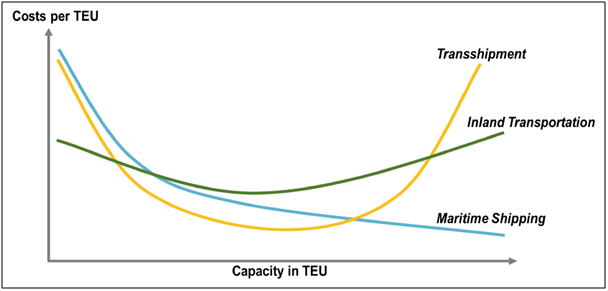Companies of any size can use consolidation service, but it is particularly useful for organizations with lean supply chains or business that operate in just in time (JIT) environments. Cargo Consolidation significantly keeps transportation costs down while developing long term collaboration with partner carriers. These allow the control of customer shipment seamless end to end.
Table of Contents
Airfreight Consolidation
Shippers use consolidated air once they need a faster transit time however it’s costlier than ocean. Virtually all air freight is consolidated. Airlines will only accept freight from freight forwarders or consolidators. It’s not feasible for airlines to individually load 500 cartons onto an aircraft within the compressed timeframes between landing and take-off. Freight are loaded onto a unit load device (ULD) essentially a 244 x 318 cm (96 x125 inch) which makes it easy to load into a plane. Forwarders consolidate freight from multiple shipper on a ULD and tender it as a built unit to the airline or collate freight from multiple shippers to airline therefore the airline builds the ULDs.

Ocean Freight Consolidation
Multiple LCL shipments from various customers is combined and loaded into one same container. Ocean is slower but less expensive and cost-effective than air. Freight forwarders typically have strategic consolidation hubs on the regions they serve, and sailing schedules for ocean shipping between major ports and terminals.

Ocean freight constitutes over 95% of the world’s distribution through global trade. These companies use logistics efficiencies from freight forwarders, consolidators, and 3PLs to manoeuvre smaller quantities of material more frequently they create a strategic decision to spend more on shipping so as that they will spend less on inventory, storage, returns, and other costs.
Reliability and Efficiency
Providers plan to specific transit times and regular sailing schedules. This is often attractive to smaller companies, who know their freight will move consistently without having to wait to fill the container. It eliminates the worth of keeping high storage of inventory which can cause damage and obsolescence, meaning the inventory goes to be outdated or cannot be used.
Shippers can often be penalized by their clients for missed or late deliveries to ensure shelves are stocked for consumers. Ships smaller volumes frequently can manage budgets and income.Ocean freight consolidation services provide clients with a price effective method of transportation, taking advantage of reduced rates since sharing the cost of a container, protected capacity, and reliable schedules enabling them to accurately plan their supply chains. Customers enjoy flexibility, protected space allocations, and cost-effective solutions.
The Economics of Inventory and Shipment
Business with continually changing, seasonal products can give shippers the adaptability to consistently re-evaluate their merchandise without wasting inventories. These shippers can likewise exceptionally use on water transit time alternative warehousing, sending cargo on the longer or shorter route to make specifically just in time savings. In the case of scanning for elective sourcing or assessing new sellers for items, LCL load can likewise be a low-sway approach to see new markets for practicality. Shipping small, consistent batches allows for vendor relationships and trust to shape when thinking scaling newly sourced goods. A consolidation service eliminates some activities that incur costs associated with an FCL shipment, locating a warehouse and workers for packing of the container. This also eliminates trucking of the container from depot and to the departure port. The consolidator will charge you for the space that your cargo occupies therefore the cost will be cheaper than FCL.

Global Logistics Strategy
These require the strategic hubs locations for optimization and maximizing volumes.
Establish locations all around the world and have local regional strength in each location trade route to deliver a seamless end to end solutions to the customer.
Investing own warehouse services in each hub to offer value-added service.A hub is a centralization of one point to receive cargoes from worldwide origins as well as locally. This enables in the creation of volumes in one single point to combined multiple LCL freight into one container per final destination.By having this centralization, it allows quickly in analysing to load a 40’GP or 40HC containers contributing to the financial aspect.
Practically consolidators choose to load a 40’ container than 20’ container due to 40ft’can load more volumes than a 20ft despite both containers relatively having quite an equivalent maximum laden weight.
Warehousing
While warehousing is the act of storing goods, it also plays a crucial role in LCL consolidation. Apart from providing proper space for the safekeeping of products, warehousing provides a system to economically coordinate the required activities, facilities and manpower, and supply for the general control of the whole operation of consolidation and deconsolidation. Companies must equip with the newest and upgraded software that will enable to ease the work of consumers. When properly managed and appropriately stocked, a warehouse provides a consistent supply of material when it’s needed and added value service, palletizing, labelling, picking, and sorting. The objectives of logistics companies are to make sure just-in-time delivery, supply chain visibility, product lifecycle transparency, and quality services.
The full content is only visible to SIPMM members
Already a member? Please Login to continue reading.
References
C H Robinson. (2018). “Global Freight Consolidation”. Retrieved from https://www.multimodal.org.uk/sites/default/files/clarion_www_multimodal_org_uk/pdfs/global-freight-consolidation-wp-en-uk-def.pdf, accessed 29/6/2020.
Green Worldwide Shipping. (2019). “LCL Consolidation: Making the Best Freight Fit”. Retrieved from https://www.greenworldwide.com/lcl-consolidation-making-the-best-freight-fit-infographic, accessed 29/6/2020.
Horizon International Cargo. (2020) “Freight Forwarding Ocean Consolidation Services”. Retrieved from https://www.hicargo.com/cargo-global-freight-forwarding/ocean-freight/consolidation-services, accessed 29/6/2020.
Sazali Salleh, PDWM. (2019).“5 best practices for effective warehouse”. Retrieved from SIPMM: https://publication.sipmm.edu.sg/five-best-practices-effective-warehouse, accessed 29/6/2020.
Stelle Tan Chee Koon, DLSM. (2020). “Essential Considerations for an Integrated Transport Solution“, Retrieved from SIPMM: https://publication.sipmm.edu.sg/essential-considerations-integrated-transportation-solution, access 29/6/2020.

